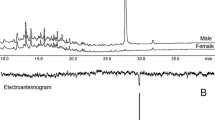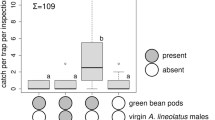Abstract
Sex-pheromone-related behavior and chemistry were studied in the wasp Spalangia endius Walker (Hymenoptera: Pteromalidae), a pupal parasitoid of the house fly, Musca domestica L. (Diptera: Muscidae). Males responded behaviorally to female extracts by arrestment, whereas females did not arrest to male extracts. In a comparison of male and female extracts by gas chromatography-mass spectrometry (GC-MS), two female-specific compounds were found. One was identified as methyl 6-methylsalicylate (gas chromatographic retention time and mass spectrum versus an authentic standard), but the chemical structure of the second compound is still unknown. Male antennae were sensitive to both compounds in electrophysiological tests (GC-EAD). Males responded behaviorally to methyl 6-methylsalicylate by arrestment, but did not arrest to the second compound. Methyl 6-methylsalicylate has been reported previously from some ant and beetle species, but never from the Pteromalidae. Chemical analysis of the extracts and the male behavioral results are consistent with the hypothesis that methyl 6-methylsalicylate functions as a female-emitted pheromone component at short range, but the exact role of both compounds in intersexual interactions in S. endius remains to be determined.



Similar content being viewed by others
References
Blomquist, G. J., and Vogt, R. G. 2003. Insect Pheromone Biochemistry and Molecular Biology. Elsevier, San Diego.
Blum, M. S., Morel, L., and Fales, H. M. 1987. Chemistry of the mandibular gland secretion of the ant Camponotus vagus. Comp. Biochem. Physiol. 86:251–252.
Brand, J. M., Fales, H. M., Sokoloski, E. A., Macconnell, J. G., Blum, M. S., and Duffield, R. M. 1973. Identification of mellein in the mandibular gland secretions of carpenter ants. Life Sci. 13:201–211.
Castracani, C., Visicchio, R., Grasso, D. A., Mori, A., Le Moli, F. A., Tullio, A. D., Reale, S., and De Angelis, F. D. 2003. Determination of the mandibular gland secretions of Polyergus rufescens queens by solid phase microextraction and gas chromatography/mass spectrometry. J. Mass Spectrom. 38:1288–1289.
Castracani, C., Visicchio, R., Grasso, D. A., Mori, A., Le Moli, F. L., Tullio, A. D., Reale, S., and De Angelis, F. D. 2005. Behavioral bioassays testing the methyl 6-methylsalicylate as a component of the female sex pheromone in the slave-making ant Polyergus rufescens (Hymenoptera, Formicidae). J. Insect Behav. 18:685–692.
Castracani, C., Tamarri, V., Grasso, D. A., Le Moli, F., Palla, G., Millar, J. G., Francke, W., and Mori, A. 2008. Chemical communication in mating behaviour of the slave-making ant Polyergus rufescens (Hymenoptera, Formicidae): 3-Ethyl-4-methylpentanol as a critical component of the queen sex pheromone. Insectes Sociaux 55:137–143.
Duffield, R. M., and Blum, M. S. 1975. Methyl 6-methyl salicylate: identification and function in a ponerine ant (Gnamptogenys pleurodon). Experientia 31:466.
Fischer, C. R., and King, B. H. 2008. Sexual inhibition in Spalangia endius males after mating and time for ejaculate replenishment. J. Insect Behav. 21:1–8.
Gnanasunderam, C., Young, H., and Benn, M. H. 1984. Defensive secretions of New Zealand tenebrionids - III. The identification of methyl esters of 6-methyl and 6-ethylsalicylic acid in Chrysopeplus expolitus (Coleoptera: Tenebrionidae). Insect Biochem. 14:159–161.
Greenberg, L., Aliabadi, A., McElfresh, J. S., Topoff, H., and Millar, J. G. 2004. Sex pheromone of queens of the slave-making ant, Polyergus breviceps. J. Chem. Ecol. 30:1297–1303.
Keeling, C. I., Plettner, K., and Slessor, K. N. 2004. Hymenopteran semiochemicals. Top. Curr. Chem. 239:133–177.
King, B. H. 1988. Sex ratio manipulation in response to host size by the parasitoid wasp Spalangia cameroni: a laboratory study. Evolution 42:1190–1198.
King, B. H. 2006. Mate location and the onset of sexual responsiveness in the parasitoid wasp Spalangia endius (Hymenoptera: Pteromalidae). Environ. Entomol. 35:1390–1395.
King, B. H. 2008. Effects of sex and mating status on who initiates contact in the parasitoid wasp Spalangia endius (Hymenoptera: Pteromalidae). J. Insect Behav. 21:387–393.
King, B. H., and Dickenson, R. M. 2008a. A behavioral study of proximal mechanisms of male recognition of female mating status in the parasitoid wasp Spalangia endius (Hymenoptera: Pteromalidae). Ann. Entomol. Soc. Am. 101:229–234.
King, B. H., and Dickenson, R. M. 2008b. Functional and nonfunctional female receptivity signals in the parasitoid wasp Spalangia endius (Hymenoptera: Pteromalidae). Environ. Entomol. 37:782–786.
King, B. H., and Fischer, C. R. 2005. Males mate guard in absentia through extended effects of postcopulatory courtship in the parasitoid wasp Spalangia endius. J. Insect Physiol. 51:1340–1345.
King, B. H., Saporito, K. B., Ellison, J. H., and Bratzke, R. M. 2005. Unattractiveness of mated females to males in the parasitoid wasp Spalangia endius. Behav. Ecol. Sociobiol. 57:350–356.
Kohl, E., Hölldobler, B., and Bestmann, H. J. 2000. A trail pheromone component of the ant Mayriella overbecki Viehmeyer (Hymenoptera: Formicidae). Naturwissenschaften 87:320–322.
Longhurst, C., Baker, R., and Howse, P. E. 1980. A multicomponent mandibular gland secretion in the ponerine ant Bothroponera soror (Emery). J. Insect Physiol. 26:551–555.
Moore, B. P., and Brown, W. V. 1979. Chemical composition of the defensive secretion in Dyschirius bonelli (Coleoptera: Carabidae: Scaritinae) and its taxonomic significance. J. Aust. Entomol. Soc. 18:123–125.
Morgan, E. D., and Ollett, D. G. 1987 Methyl 6-methylsalicylate, trail pheromone of the ant Tetramorium impurum. Naturwissenschaften 74:596–597
Rueda, L. M., and Axtel, R. C. 1985. Guide to common species of pupal parasites (Hymenoptera: Pteromalidae) of the house fly and other muscoid flies associated with poultry and livestock manure, Technical Bulletin 278. North Carolina Agricultural Research Service, North Carolina State Univ., Raleigh, NC.
Ruther, J., and Steiner, S. 2008. Costs of female odor in males of the parasitic wasp Lariophagus distinguendus (Hymenoptera: Pteromalidae). Naturwissenschaften 95:547–552.
Ruther, J., Homann, M., and Steidle, J. L. M. 2000. Female-derived sex pheromone mediates courtship behaviour in the parasitoid Lariophagus distinguendus. Entomol. Exp. Appl. 96:265–274.
Ruther, J., Stahl, L. M., Steiner, S., Garbe, L. A., and Tolasch, T. 2007. A male sex pheromone in a parasitic wasp and control of the behavioral response by the female’s mating status. J. Exp. Biol. 210:2163–2169.
Ruxton, G. D., and Beauchamp, G. 2008. Time for some a priori thinking about post hoc testing. Behav. Ecol. 19:690–693.
Schönrogge, K., Napper, E. K. V., Birkett, M. A., Woodcock, C. M., Pickett, J. A., and Thomas, J. A. 2008. Host recognition by the specialist hoverfly Microdon mutabilis, a social parasite of the ant Formica lemani. J. Chem. Ecol. 34:168–178.
Steiner, S., Hermann, N., and Ruther. J. 2006. Characterization of a female-produced courtship pheromone in the parasitoid Nasonia vitripennis. J. Chem. Ecol. 32:1687–1702.
Torres, J. A., Snelling, R. R., Blum, M. S., Flournoy, R. C., Jones, T. H., and Duffield, R. M. 2001. Mandibular gland chemistry of four Caribbean species of Camponotus (Hymenoptera: Formicidae). Biochem. Syst. Ecol. 29:673–680.
Wiley Spectral Library [CD-ROM], 6th edn. 1995. Wiley, New York.
Acknowledgments
We thank D. Klumpp for use of his laboratory and V. Ryzhov, J. Miller, and N. Blackstone for feedback on the manuscript.
Author information
Authors and Affiliations
Corresponding author
Rights and permissions
About this article
Cite this article
Nichols, W.J., Cossé, A.A., Bartelt, R.J. et al. Methyl 6-Methylsalicylate: A Female-Produced Pheromone Component of the Parasitoid Wasp Spalangia endius . J Chem Ecol 36, 1140–1147 (2010). https://doi.org/10.1007/s10886-010-9855-6
Received:
Revised:
Accepted:
Published:
Issue Date:
DOI: https://doi.org/10.1007/s10886-010-9855-6




